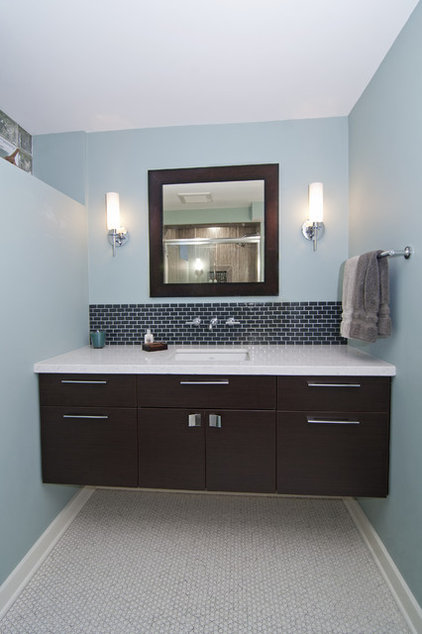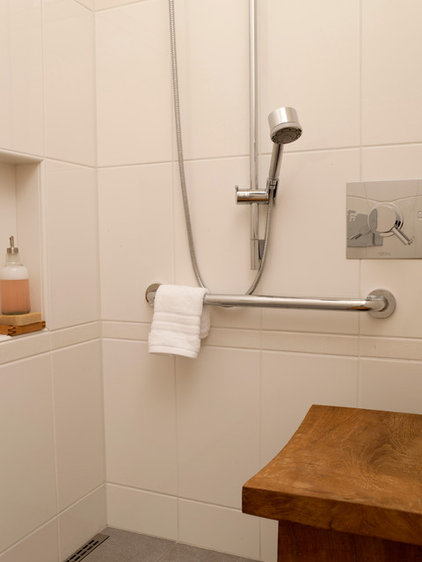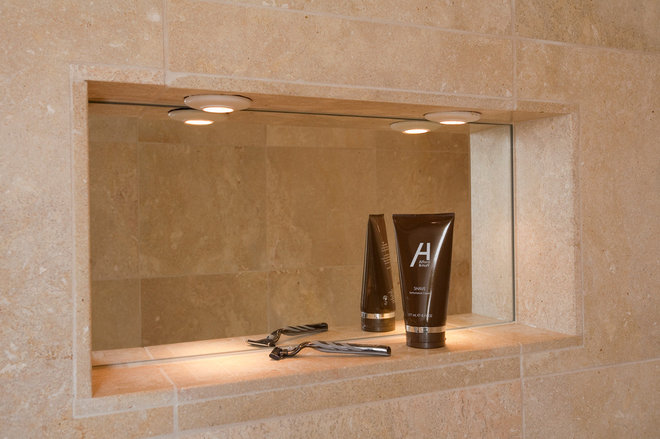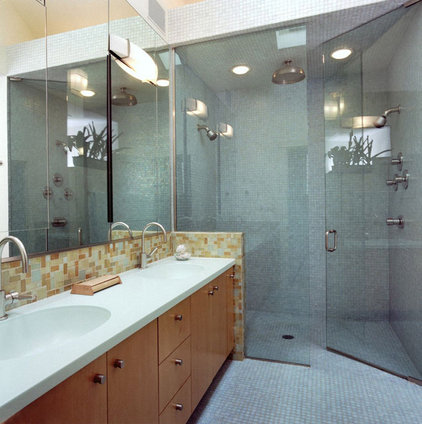Let’s say you live in an older house, something that was built prior
to the 1980s. The bathrooms were, at the time the house was built,
state of the art and everything your parents and grandparents wanted.
But we’re in the 21st century now, and those bathrooms just don’t bring a
smile to your face. Perhaps it’s because the vanity is too low.
Perhaps it’s that the shower valve was made prior to the advent of
antiscalding valves. Perhaps it’s the lighting, which makes you look
old and tired when you’re standing at the sink shaving.
Whatever
the reason, reworking a bathroom can go a long way toward making your
home much more enjoyable — and valuable. We don’t live in an age of
excess anymore (that was so last decade). What we want to do is be
smart about what improvements we make, to invest our money wisely in the
things that really matter, to create bathrooms that are wonderful
retreats without looking like a room in Versailles.
To do this
you’ll want to have a checklist of what’s possible. Then move forward
with incorporating the stuff you really need to make your bathroom
function — and saying no to the rest. Here are a few things to consider.
Is that tub really necessary?
For many years homeowners have been told that they have to have a
“garden tub” in a main bathroom. It didn’t matter that no one would
ever use it. And it didn’t matter that the cost of the tub — from
building the extra area needed to house it to all of the long-term costs
— would put a real dent in the homeowner’s wallet. What mattered was
resale and having that tub to make sure the house could be sold.
So
ask yourself if you really want that tub. If you’re a bath person, ask
yourself if the tub has to be in the main bathroom, or if you can do
with a nice-size tub in the hall bath.
How to convert your tub space to a shower
Mind the height. If your
home is more than a few decades old, your bathroom vanity is likely 30
inches high. While that height can be great for smaller children, it
really doesn’t work for adults. The standard now is 36 inches, which is
comfortable for most adults.
If a 36-inch vanity is too high for
you, and you don’t want to invest in a custom vanity, consider a
floating one. These can be placed at just about any height you’d like;
simply adjust the space between the floor and the vanity. Just make
sure to have enough support in the wall so that the vanity can easily
hang without coming loose.
Water, water everywhere.
Today’s showering experience has almost unlimited possibilities.
Standard showerheads are just a starting point. There are body sprays,
handhelds, rain heads and more. Keep in mind that each of these items
will increase the cost of your project, as each will increase both your
rough and trim plumbing costs as well as your fixture costs.
And
while you’re at it, plan out the location of each of these elements.
For example, consider placing a standard showerhead up higher on the
wall if you’re tall. And if you plan on having a shower bench, why not
make sure the handheld can be used while you’re shaving your legs?
And
please don’t put the controls in a place where they can’t be reached
without getting into the shower. Getting dowsed by that initial spray
of cold water is something you can live without.
Grab on for safety.
Whenever I think of grab bars, I imagine hospital bathrooms. But these
really useful and terrific safety elements don’t have to be
afterthoughts that give your bath an overly institutional aesthetic.
There are many designs that are quite striking and, when placed
judiciously, can be beneficial to anyone raising themselves from the tub
or shower bench.
Make sure you provide adequate blocking in the
walls if you do want to include grab bars in your project. These are
not the kinds of elements that can be attached to a wall with a plastic
anchor. You’ll want to make sure they are securely anchored into
something solid so they will last for years.
A place to rest. A shower
seat isn’t just a comfy place to relax; it can also be support for
shaving your legs. For a small shower where you don’t want to have the
seat permanently taking up much-needed floor space, consider a folding
bench, which runs a few hundred dollars.
As with a grab bar, you’ll want to make sure a folding bench is securely attached to the wall.
Find your niche. A great
way to provide space for shampoo bottles, conditioner bottles and even
things like candles is to create a niche or series of niches in the wall
of a shower or bath area. These niches are a welcome alternative to a
plastic shower caddy or the shower floor, and since they are inexpensive
to construct, there’s a lot of value to be had.
The trick to
having these niches is coordinate their placement with the tiling
pattern. It’ll mean selecting your tile early, not changing your mind,
and having the wall framed to accept the niche.
Do you shave in the shower? I’ve
always found the shower to be the best place to shave. If you do too,
consider spending a few hundred dollars extra to add proper lighting, a
fog-free mirror and a place for a razor and shaving cream.
Getting your game face on.
Do you stand at the vanity to put your makeup on? Would you rather
have a place to sit to do so? A place with a big mirror and all of your
cosmetics stored neatly at hand? If so, consider a makeup desk. If
you choose to integrate one with your vanity, you’ll have to recognize
the height difference. While a vanity for an adult tends to be 36
inches or so tall, a makeup desk is usually 30 inches. If you really
want a large, uninterrupted counter, you’ll want to look into a seat
that’s stool height for the makeup desk.
Forgo the threshold. While creating a
zero-threshold shower
during a renovation can cost extra, it could well be worth the added
expense to create a shower where you can gracefully age in place. And
the cost, depending on structural issues, could be as low as a few
hundred dollars — a small price to pay to not have to ever trip on a
raised shower sill, something you’ll appreciate every time you get in
and out of the shower.
Time to get steamed. Steam showers were
all the rage for many, many years. It seems that I didn’t do a main
bath without one. And the bigger, the better. Some steam showers were
large enough to accommodate a Super Bowl party. And while there’s less
demand for steam showers today, you should always consider one,
especially if you have a home gym that you use regularly.
Keep in
mind: Steam showers can easily add several thousand dollars to the cost
of a project. And don’t try to save money by undersizing the steam
generator. Make sure you calculate the cubic volume, not just the
square footage, of the shower space and then go by the manufacturer’s
recommendation for size. Also, make sure the generator is located in an
accessible spot, a place that workers can get to easily. Steam
generators are machines, and any machine can fail, no matter what its
age is.
Keep reading material nearby.
Yes, the best seat in the house is where some of us do quite a bit of
reading. So why not have a place for those books, magazines, newspapers
etc. that always seem to find their way to the throne room? This is a
fairly inexpensive thing to do and a way of keeping the room neat and
tidy.
Hooks, towel bars and the T.P. holder.
Seems that the placement of these things, always a necessity, is the
last thing to be considered. They really shouldn’t be an afterthought,
especially when they can be such fun design elements. So when planning
your project, think about where the hooks, towel bars, toilet paper
holders and the like will go so that you can get that
all-too-often-overlooked blocking installed in the wall.











